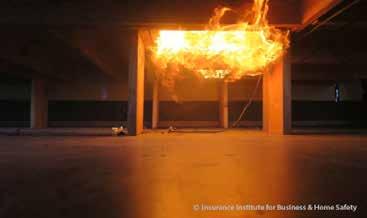
3 minute read
Fire Spread on Ember-Ignited Decks
Wind-blown embers generated during wildfires are the single biggest hazard wildfires pose to homes, and homeowners should never overlook the potential risk that an attached deck can create. Recent testing by the Insurance Institute for Business & Home Safety (IBHS) offers important findings that can help minimize risk from wind-blown embers to decks.
Nothing that can ignite should be stored under a deck. This action, along with development of effective and well-maintained home ignition zones, will minimize the chance of all but a windblown ember exposure to your deck. An ignited deck can result, for example, in the ignition of combustible siding, or glass breakage in a sliding glass door
Advertisement
About The Research Tests
regardless of the deck board’s orientation
IBHS’s tests evaluated how an ember-ignited (parallel or perpendicular). When deck fire on an attached deck can spread to the boards were perpendicular to the building, home, and yielded important guidance to the fire would spread in the gap between minimize the chance of fire spread to the boards. The 1/8” gap between deck boards house. Tests showed that the fire was typically was narrow enough for the fire to continue small (Figure 1), sometimes just smoldering burning into the unburned wood (the fuel), (not flaming). It spread slowly, taking more in both directions from the ignition point. The than an hour to travel the 4 to 6 feet from the fire spread pattern was more complicated ignition point to the home. Research from when deck boards were parallel to the test IBHS showed all ember-ignited deck fires building. In this case, fire could spread occurred in the gaps between deck boards parallel to the test building, or directly to it. and initially started as a small smoldering fire

Fire spread directly to the building included a that transitioned to a flaming fire. Although smoldering mode that occurred in the space these small fires self-extinguished during between the top of the joist and the bottom IBHS tests that did not include any wind, of the deck board. Flaming combustion wildfires almost always involve elevated wind occurred when smoldering reached a gap speeds. During lab tests, even mild wind between deck boards. Lateral flame spread speeds of 12 mph, enabled fires to spread. can result in the ignition of joist members, Under certain conditions, the small fire did resulting in fire growth. grow, always in the under-deck area (see Figure 2). Our results demonstrated that fire growth occurred in the under-deck area when joist spacing was 8” to 12”, less than the

IMPORTANCE of the
Home Ignition Zones
To minimize the possibility of deck ignitions, typical 16”. reduce fuels in the home ignition zones by Wind blowing against a building has a return carefully selecting and positioning vegetation flow component, so if fire were able to burn and implementing regular maintenance. to the home, it would have to travel there as Pay particular attention to the area under a backing fire, or against the wind. Research the footprint of the deck, where storage of shows the “fuel” has to be close together for combustible materials should be avoided. this to occur. That “fuel” could be the deck Although there are noncombustible deck boards, or a combination of deck boards and board and decking options, many of the support joists. commercially available deck board products are combustible. IBHS research on deck
HOW DOES THE FIRE SPREAD?
materials is available at: disastersafety.org/ IBHS tests demonstrated that fire spreads ibhs/wildfire-ignition-potential-decks- both toward, and away from, the house subjected-ember-exposure
Construction Recommendations
IBHS research shows that, for medium density softwood decking products (such as redwood and cedar), which can be vulnerable to ignition from embers, the associated fire spread on the deck can be minimized by the following:
1. Increase the gap between deck boards from 1/8 inch to 1/4 inch.
Fire spread in the gap between deck boards. Note the small flame burned all the way to the test building.
2.Increase joist spacing from 16 inches to 24 inches.
Narrow joist spacing was a condition that could result in fire growth in the under-deck area.
3. Apply a foil-faced selfadhering adhesive flashing tape (foil-faced bitumen tape) on the top of each joist.
Using a foil-faced self-adhering bitumen flashing tape reduces flame spread by removing the joist as a fuel source for both parallel and perpendicular deck board installations.











